Choosing the Right Morgue Table: A Decision Guide
Morgue tables are specialized workstations designed for the preparation, examination, and care of deceased individuals in funeral homes, medical facilities, and pathology labs. They serve critical functions in embalming, autopsy, and body presentation processes.
| Morgue Table Type | Primary Use | Key Features | Price Range |
|---|---|---|---|
| Embalming Tables | Body preparation | Perforated surfaces, drainage systems | $659-$4,500 |
| Autopsy Tables | Medical examination | Integrated sinks, splash guards | $6,000-$19,995 |
| Dissection Tables | Educational/Research | Immersion capabilities, precision lighting | $5,000-$8,250 |
| Transport Carts | Body movement | Locking casters, concealed design | $1,200-$3,500 |
When selecting a morgue table, funeral directors must consider several critical factors:
- Material construction - 304 stainless steel is industry standard for durability and easy cleaning
- Dimensions - Standard sizes range from 32"×80" to 35"×85" with customization available
- Weight capacity - Standard tables support 600-750 lbs; bariatric options up to 1,000 lbs
- Height adjustment - Ergonomic models offer 30"-38" range for staff comfort
- Drainage systems - Essential for fluid management with 3" troughs and 6" drain stems
The right table not only improves workflow efficiency but also improves safety, reduces staff injuries, and ensures proper respect for the deceased and their families.
I'm Mortuary Cooler, a national-level supplier of mortuary equipment with extensive experience helping funeral homes select and implement the ideal morgue tables for their specific needs and budget constraints. My team specializes in American-made mortuary solutions that combine durability with customizable features.

Simple MORGUE TABLES word guide:
MORGUE TABLES 101: Functions, Safety and Workflow
When you walk into a modern prep room, the morgue table stands as the centerpiece of the entire operation. Far more than just a surface, these specialized workstations serve as command central for the care of the deceased – supporting everything from embalming and autopsy procedures to preparation for final viewing.
A quality morgue table does three things exceptionally well: it supports proper technique, protects staff health, and maintains dignity for the deceased. The thoughtful engineering behind these tables addresses the practical realities of handling biological materials while making the work less physically demanding.
"The day we upgraded to a hydraulic-lift table was the day my back stopped hurting," shares Tom, a funeral director from Nashville who works with our equipment. "After 30 years in this profession, I finally stopped dreading long preparation sessions."
Modern morgue tables incorporate ergonomic features that significantly reduce staff injuries. The ability to adjust table height between 30-38 inches means embalmers of different heights can maintain proper posture throughout lengthy procedures. This seemingly simple feature has dramatically reduced back injuries and repetitive strain issues among funeral professionals.
Effective fluid drainage represents another critical function. Well-designed morgue tables feature 3-inch troughs and 6-inch drain stems that efficiently channel fluids away from work areas, preventing spillage while meeting strict OSHA regulations for handling biological materials. Some newer models even incorporate UV sterilization features that can be activated overnight, reducing bacterial growth between uses.
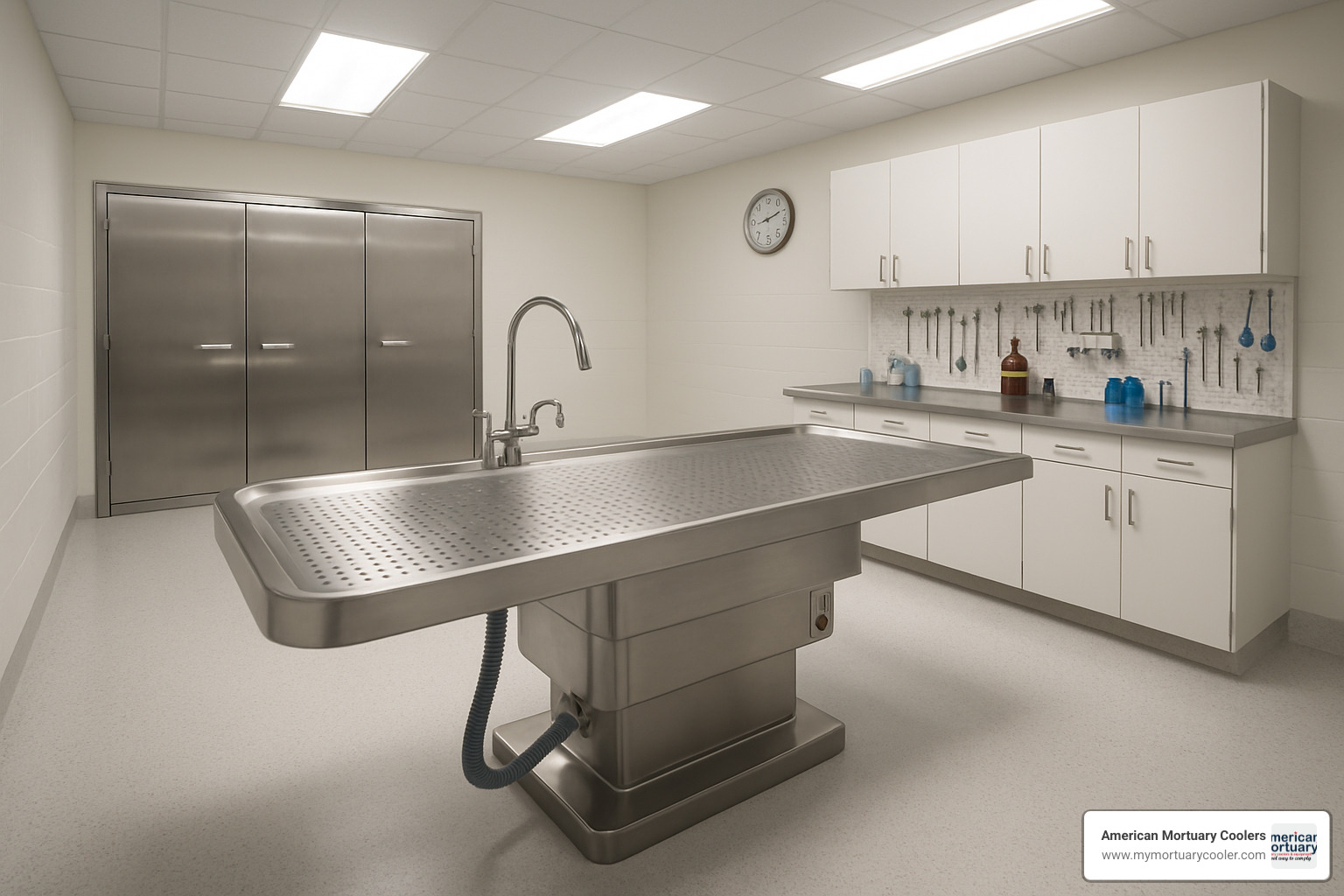
Primary Functions of MORGUE TABLES
Body preparation stands as the most common use for morgue tables in funeral homes. The specialized design includes perforated surfaces that channel fluids away from the body into drainage systems, maintaining a clean, dignified environment throughout the embalming process. The right table makes all the difference in creating a peaceful, presentable appearance for final viewing.
In medical settings, anatomical study becomes the primary purpose. Autopsy and dissection tables enable detailed examination for educational, research, or forensic purposes. These specialized tables often feature improved lighting, integrated measurement tools, and surface treatments that improve visibility of fine anatomical details.
For forensic applications, evidence preservation becomes paramount. As Dr. Sarah Jenkins, a forensic pathologist in Memphis, explains: "A proper forensic table can make or break a case. The grid plates and specialized drainage systems help capture trace evidence that might otherwise wash away. In court proceedings, these details matter tremendously."
According to scientific research on morgue sanitation, proper equipment significantly reduces cross-contamination risks between cases – a critical factor in both medical and funeral settings.
How Good Tables Reduce Risk
Quality morgue tables incorporate thoughtful safety features that protect both staff and the integrity of the deceased. A slight 1-2° slope toward the drain ensures fluids move naturally away rather than pooling, improving visibility while reducing contamination risks.
The marine edges and splash guards (typically ¾" to 1" high) prevent fluids from reaching the floor – a simple feature that prevents countless slip accidents and the liability claims that follow. One funeral home director told us: "Those raised edges have probably saved us thousands in potential workers' comp claims over the years."
Height adjustment mechanisms allow staff to position the table optimally, reducing physical strain during long procedures. Studies show adjustable-height tables can reduce work-related musculoskeletal disorders by up to 40% – a significant benefit in a profession already physically demanding.
Perhaps most impressive are the anti-microbial welds found in premium morgue tables. These heliarc-welded seams are polished to a seamless finish, eliminating crevices where bacteria can accumulate and significantly reducing cross-contamination between cases. This construction detail separates truly professional-grade equipment from lesser alternatives.
The thoughtful design of modern morgue tables reflects a deep understanding of the funeral profession's unique challenges. When staff can work safely and efficiently, they can focus on what truly matters – providing respectful, dignified care for the deceased and compassionate service to families during their most difficult moments.
Comparing Table Types: Embalming, Autopsy, Dissection, Transport
When selecting a morgue table, understanding the different types and their specific uses can save you time, money, and frustration. Think of it like choosing the right vehicle – you wouldn't use a sports car to move furniture, and similarly, each morgue table has been designed with specific procedures in mind.
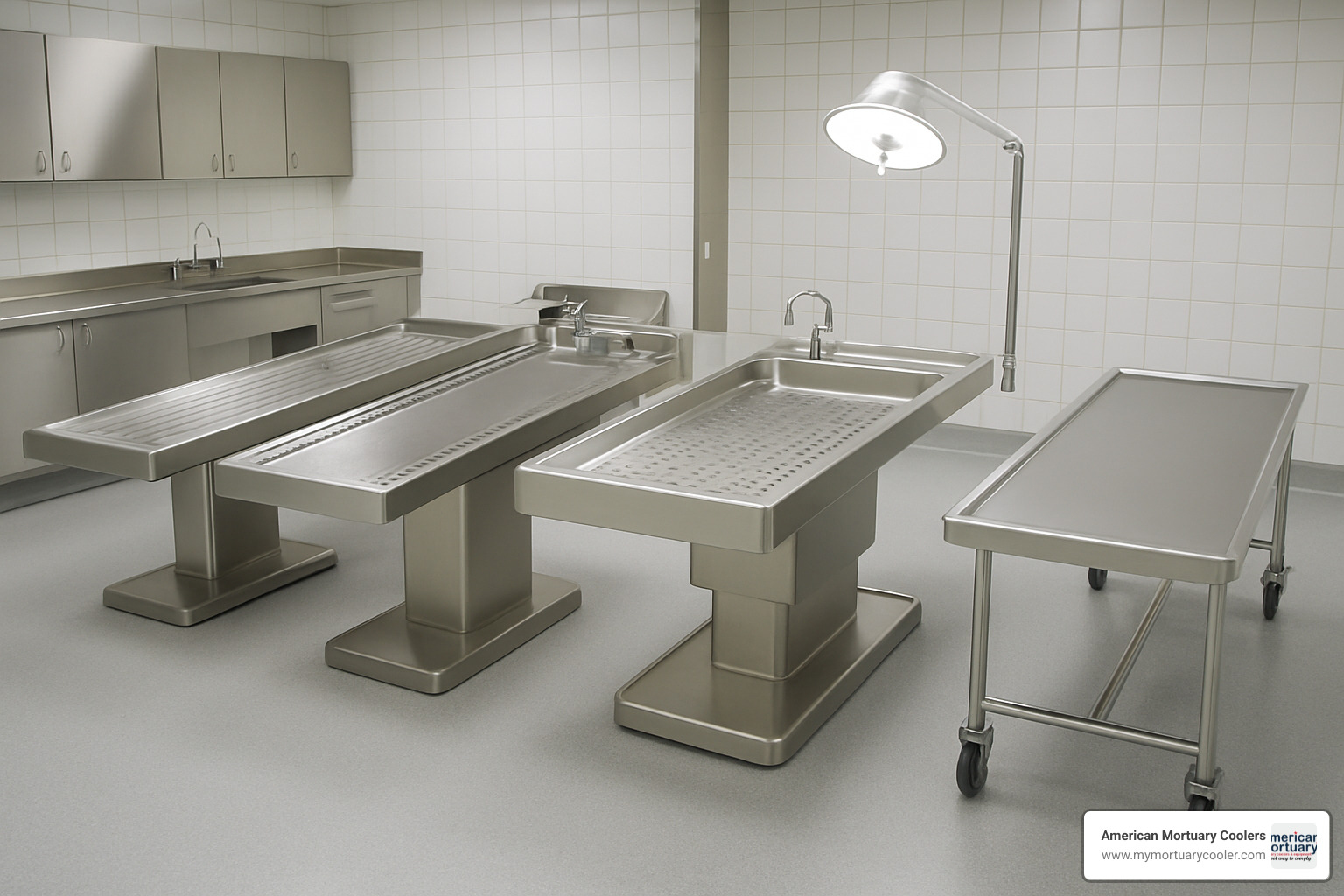
Embalming MORGUE TABLES
Embalming tables are the workhorses of funeral preparation rooms. They're specifically designed to support the careful art of preservation while keeping things clean and comfortable for the embalmer.
The best embalming tables feature perforated surfaces that allow fluids to drain away from the body during the embalming process. This seemingly simple feature makes a world of difference in maintaining a clean, efficient workspace.
"We upgraded to a hydraulic embalming table last year," shares a funeral director from Dallas who works with our equipment. "The difference in our preparation quality and staff comfort is night and day. The investment paid for itself within months through increased efficiency."
For smaller preparation rooms, folding embalming tables offer a practical solution. They support up to 600 lbs when in use but can be tucked away when space is needed for other activities. Meanwhile, multi-height designs provide a happy medium between basic models and the premium hydraulic systems that adjust between 30-38 inches with the press of a pedal.
Want to learn more? Check out our Embalming Table roundup for funeral professionals.
Autopsy & Necropsy Tables
Autopsy tables serve a different purpose entirely, focusing on medical examination rather than preparation. The design differences might seem subtle to an untrained eye, but they make all the difference to pathologists and medical examiners.
The most distinctive feature is often the pedestal design, which allows 360° access around the body – essential for thorough examination. More advanced models include pedestal-tilt functionality that improves fluid drainage and provides better visualization during procedures.
For specialized applications, immersion tables include stainless-steel trays that can submerge cadavers for prolonged study, while covered designs offer discretion when examinations need to be paused or when privacy is paramount.
Forensic facilities often opt for tables with specialized lighting, integrated scale systems, and improved drainage options specifically designed for evidence collection and preservation.
For a deeper dive into these specialized workstations, visit our in-depth analysis of Autopsy Tables in forensic pathology.
Dissection & Teaching Tables
Educational institutions face unique challenges that require specialized morgue tables that balance teaching needs with proper preservation and safety standards.
Electric immersion dissection tables have revolutionized anatomy education by integrating stainless-steel trays that can fully submerge cadavers. "Our students can return to the same specimen over weeks rather than days," explains an anatomy professor from Chicago who uses our equipment. "This allows for more thorough learning without the preservation challenges we faced with older equipment."
These teaching tables often feature gas-spring pedal systems for hands-free height adjustment – particularly valuable when instructors need to demonstrate techniques to groups of students. Meanwhile, overflow drains prevent fluid spillage even when tables are filled to capacity, an essential safety feature in busy teaching labs.
Transport Carts & Carriers
The final category addresses the critical need for dignified, safe transportation of the deceased. These specialized carts ensure respect and safety during what can be a logistically challenging aspect of mortuary work.
Concealed carts maintain privacy during movement through public areas, while lightweight cadaver stretchers reduce staff strain during transfers. For facilities serving diverse communities, bariatric trolleys provide expanded platforms (typically 35"×84") and higher weight capacities up to 1,000 lbs.
The quality of the wheels matters more than you might think – premium transport tables feature 6-8" locking casters that provide smooth movement across different flooring surfaces and secure positioning once in place.
The hydraulic covered cadaver carrier represents the gold standard in this category, combining height adjustment with dignified concealment during transport – a thoughtful solution for facilities where transportation routes may pass through public areas.
Looking for more ways to improve your preparation room efficiency? Check out our guide to Prep Room Tables that make mortuary work easier.
Specifications & Customizations: Materials, Dimensions, Weight, Cultural Compliance
When choosing a morgue table for your facility, the details really do matter. From the materials that stand up to daily use to dimensions that accommodate your specific needs, these specifications aren't just technical points—they're the foundation of a functional preparation room that serves your community with dignity.
Why 304 Stainless Still Rules
There's a reason 304 stainless steel remains the industry favorite despite newer materials entering the market. This workhorse material contains about 18% chromium and 8% nickel, creating a self-healing protective layer that keeps your morgue table looking professional year after year.
The magic happens at the molecular level—when scratched, the chromium oxide layer actually repairs itself, protecting against the harsh chemicals used in embalming and autopsy procedures. The heliarc-welded seams create joints as strong as the base material while remaining seamless, eliminating hiding places for bacteria that could compromise your sanitation protocols.
"I've had my 304 stainless table for over 15 years of daily use," shares one funeral director from Tennessee, "and visitors still comment on how new it looks. That investment has paid for itself many times over."
Most quality morgue tables use 14-gauge 304 stainless steel, striking the perfect balance between durability and weight. While 316 stainless offers slightly better corrosion resistance, the additional cost rarely justifies the minimal benefit for most funeral homes.
When Size Matters
Finding the right dimensions for your morgue table isn't just about measuring your prep room—it's about serving your community appropriately while working within your space constraints.
Standard tables typically measure between 32"×80" and 35"×85", dimensions that accommodate most individuals while still fitting through standard doorways. However, with changing demographics, many forward-thinking funeral homes now include at least one bariatric-capable table, usually 35" wide with reinforced construction supporting up to 1,000 pounds.
For smaller preparation rooms, space-saving options like folding legs or multi-height tables with smaller 30"×78" footprints can provide full functionality without crowding your workspace. Some jurisdictions have specific requirements for morgue table dimensions, particularly in medical examiner facilities—something our team helps customers steer based on local regulations.
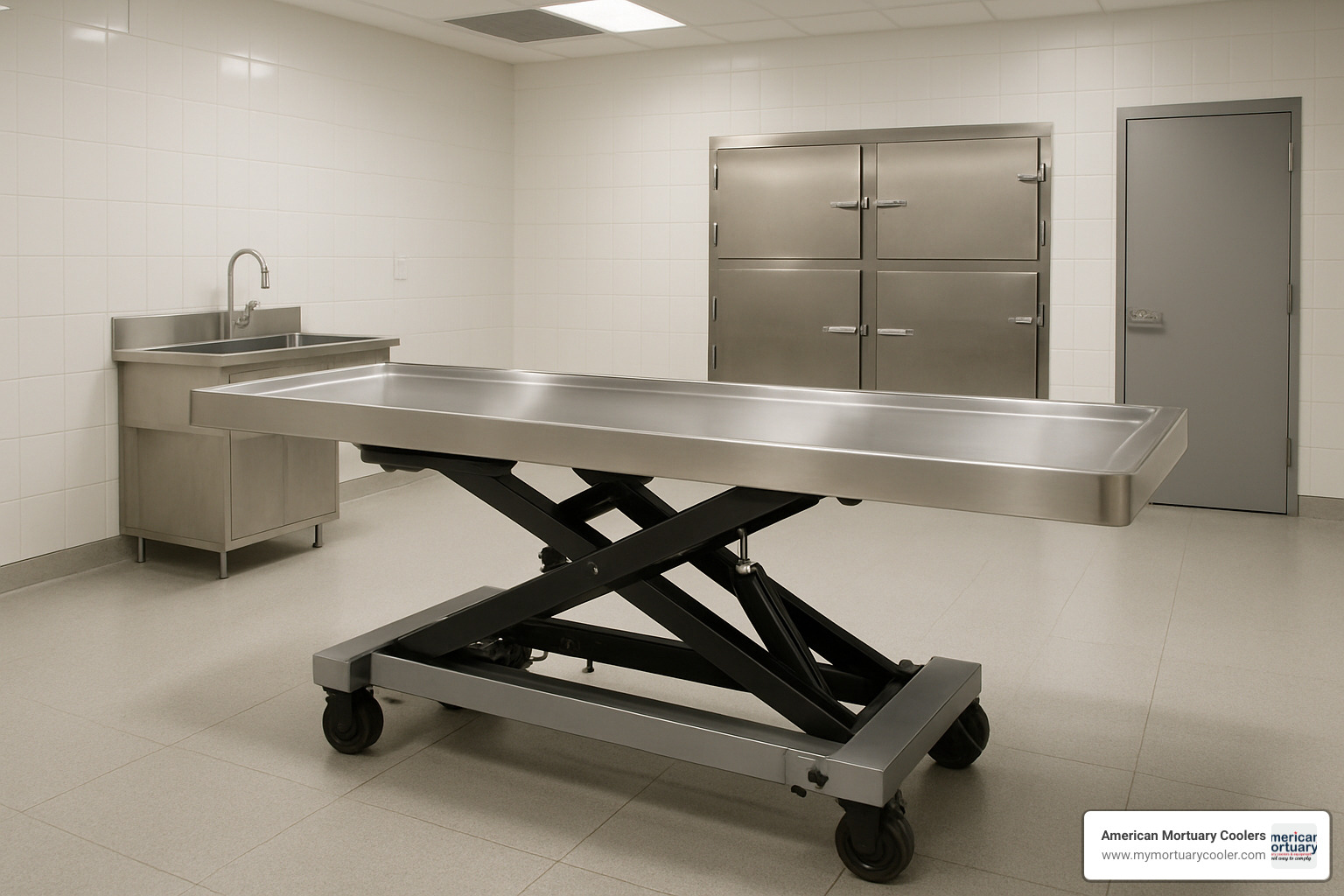
Cultural Adaptations for Faith-Based Care
One of the most meaningful advances in modern morgue tables is their ability to accommodate diverse religious and cultural practices with dignity and respect.
For Muslim families requiring ritual washing (ghusl), specialized tables feature improved drainage systems and removable head supports that facilitate this sacred process. Jewish preparation rooms often benefit from tables with removable perforation plates that can be swapped for solid surfaces during tahara (ritual purification), as some interpretations discourage drainage during this ceremony.
Some faith traditions, like certain Bahá'í practices, prefer preparation without drainage, making tables with optional drain closure systems particularly valuable. These thoughtful adaptations allow funeral homes to serve diverse communities with appropriate respect for their traditions.
A funeral director serving a multicultural community in our Nashville service area puts it perfectly: "Having a table that adapts to different cultural needs has transformed how we serve families. When people see we've taken the time to honor their traditions properly, it means the world to them during a difficult time."
At American Mortuary Coolers, we understand these specifications aren't just technical details—they're the foundation of providing compassionate, appropriate care to the families you serve. Our team specializes in helping you steer these choices to find the perfect fit for your facility's unique needs.
Next-Gen Features & Prep-Room Integration
Today's advanced MORGUE TABLES blend innovation with practicality, creating workstations that not only perform better but also make the challenging work of funeral professionals a little easier. These modern designs reflect a deep understanding of what happens in a busy preparation room.
The evolution of MORGUE TABLES has been driven by the people who use them every day. As one preparation room manager from Tennessee told us, "It's the little things that make the biggest difference when you're spending hours at the table."
Accessories That Save Time
The right accessories transform a basic MORGUE TABLE into a complete workstation that reduces physical strain and improves efficiency.
Adjustable armrests have become game-changers for many embalmers. These simple supports hold limbs in position during preparation, freeing up your hands and reducing the need for an assistant. Similarly, integrated tool racks keep instruments within easy reach – no more searching for that trocar or aneurysm hook when you need it most.
Many of our customers have found that built-in LED lighting systems dramatically improve visibility without creating shadows or glare that can hinder detailed work. These lights illuminate the work area without requiring adjustments to overhead fixtures.
"The retractable splash curtains on my new table have cut my cleanup time in half," shared a funeral director from our Georgia service area. "No more wiping down walls after arterial injections."
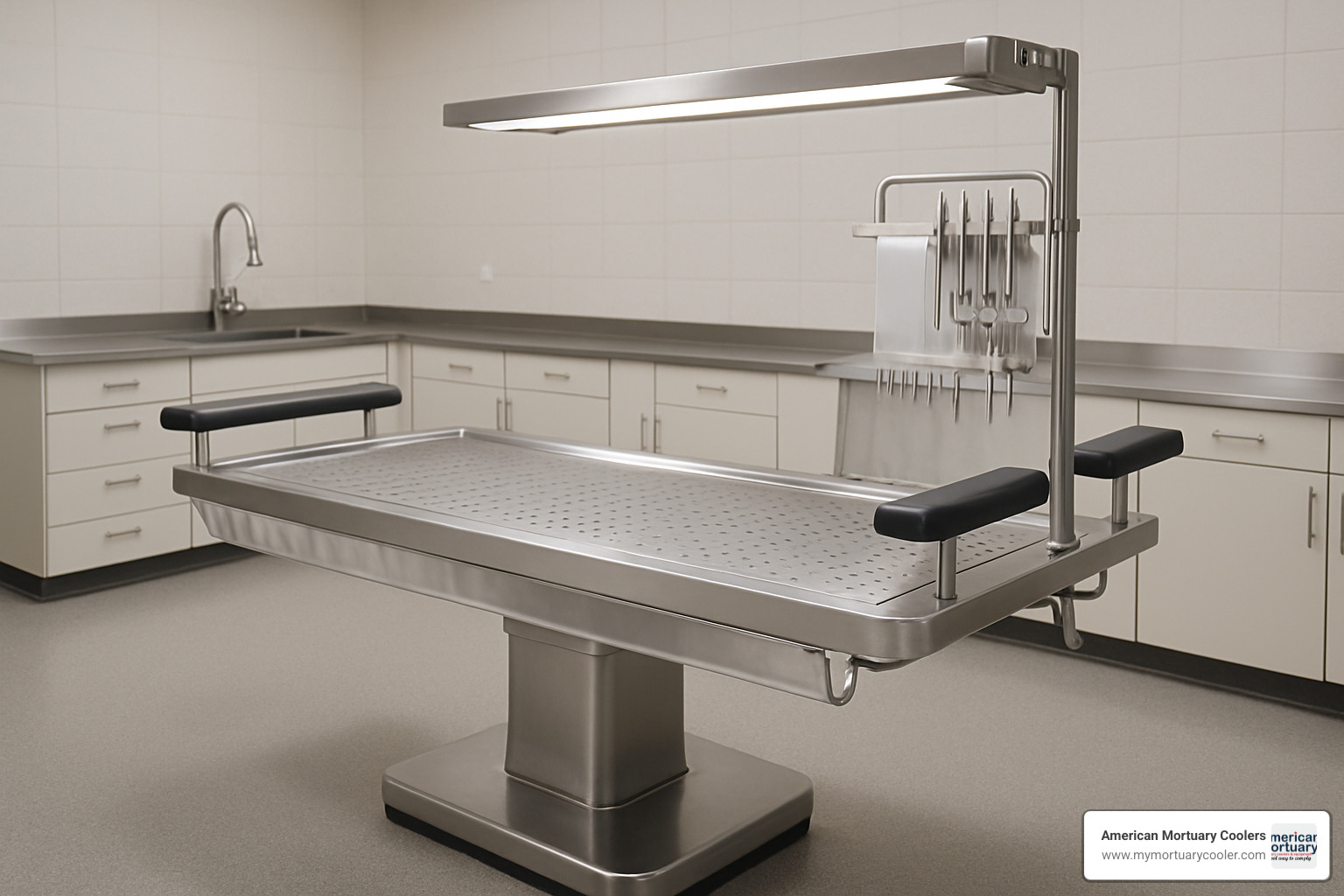
Beyond these accessories, modern MORGUE TABLES incorporate features that integrate seamlessly with your entire preparation room. Hydraulic lift systems quietly adjust table height from 30 to 38 inches, accommodating staff of different heights without strain. Premium models offer push-button electric elevation for precise positioning without manual pumping.
Foot pedals have become increasingly popular, allowing hands-free control of height and drainage systems – particularly valuable when you're wearing gloves and working with biological materials. The removable grid plates on perforated tables can be completely removed for thorough cleaning, extending table life while maintaining sanitary conditions.
Many funeral homes are finding the benefits of integrated hydro-aspirators that eliminate the need for separate suction equipment. Side rails provide security during transport without interfering with access during procedures, while body bridges lift the torso for improved access during arterial injection.
Heavy-duty casters (typically 6–8 inches) allow easy repositioning even with bariatric cases, and quick-connect plumbing fittings simplify installation and maintenance. As one preparation room manager told us, "Being able to disconnect and reconnect the drain system in seconds makes deep cleaning so much easier."
Tech Trends & Innovations
The future of MORGUE TABLES is arriving faster than you might expect. Several forward-thinking funeral homes have already adopted tables with IoT sensors that monitor conditions and alert staff to potential issues before they become problems.
Antimicrobial coatings that incorporate silver ion technology are becoming more common, actively inhibiting bacterial growth between cleaning cycles. This added layer of protection reduces cross-contamination risks and provides peace of mind in busy facilities.
Modular designs with quick-swap tops are gaining popularity too. These versatile systems allow you to exchange different surface types (solid, perforated, or channeled) depending on the procedure, without needing multiple complete tables. This flexibility is especially valuable for smaller preparation rooms where space is at a premium.
Environmental consciousness has reached the MORGUE TABLE industry as well, with manufacturers developing stainless steel alloys that include recycled content while maintaining the same performance standards. These green materials reduce environmental impact without sacrificing durability.
"I never thought I'd be excited about technology in preparation room equipment," laughed a funeral director from our Midwest service region. "But these new tables have made our work noticeably easier. What used to require three separate pieces of equipment now functions as one coordinated system, saving us both space and time."
At American Mortuary Coolers, we've seen how these advancements improve the daily work of funeral professionals. The right table doesn't just support the deceased – it supports the important work you do every day.
Budget, Brands, Upkeep & FAQs
When it comes to investing in a morgue table, finding the sweet spot between quality, functionality, and budget is essential. Let's talk about what you can expect to spend, which brands deliver consistent quality, and how to keep your equipment in top condition for years to come.
The price spectrum for morgue tables is quite broad, ranging from basic folding models starting around $659 to sophisticated electric and hydraulic systems that can reach $19,995 or more. Several factors influence where a particular table falls on this spectrum:
Material quality makes a significant difference – while all professional tables use stainless steel, the thickness, finish quality, and welding techniques directly impact both durability and price. Mechanical features also play a major role; manual tables cost less upfront but may increase labor costs over time, while hydraulic and electric models command premium prices but significantly improve staff efficiency and reduce physical strain.
Weight capacity considerations can't be overlooked either. Standard tables supporting 600-750 lbs typically cost 20-30% less than their bariatric counterparts rated for 1,000 lbs or more. And if you need customized features like integrated scales, improved drainage systems, or cultural adaptations, expect to add roughly 15-25% to the base price.
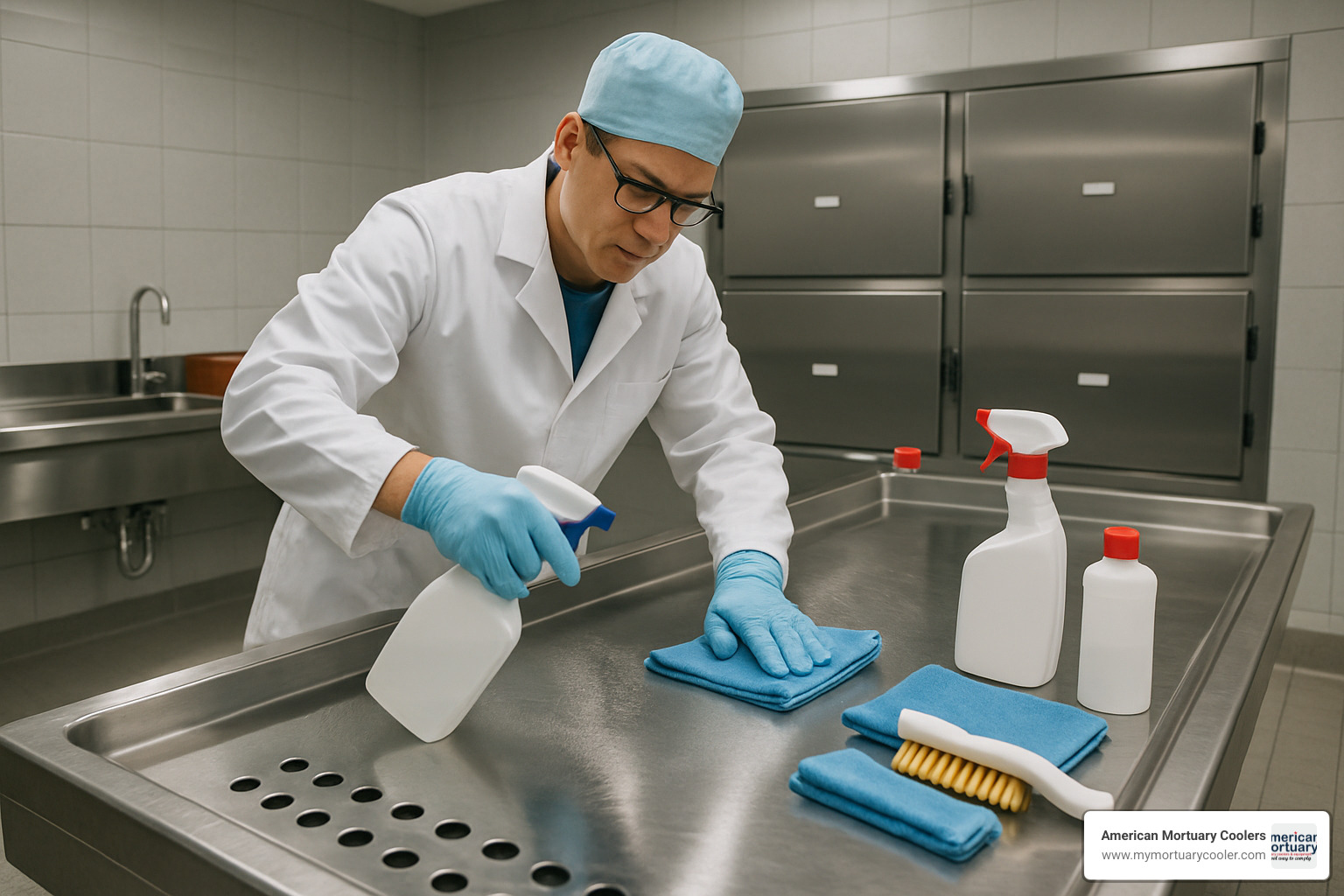
When it comes to trusted manufacturers, several brands have established solid reputations in the morgue table market:
Mortech has earned its following through durability and straightforward designs that emphasize reliability without unnecessary frills. CSI Jewett tends to specialize in high-end autopsy and forensic examination tables with advanced features that medical examiners particularly appreciate. MOBI offers perhaps the widest range of options from basic to premium, with strong customization capabilities to match specific facility needs. Mopec rounds out the top tier with its focus on innovation and seamless integration with comprehensive prep room systems.
At American Mortuary Coolers, we've built partnerships with these quality manufacturers to provide direct shipping to all 48 contiguous states. This means you receive exactly the right table for your specific needs without unnecessary markups that often come with multiple middlemen.
How to Maintain Your MORGUE TABLES
Taking proper care of your morgue table isn't just about protecting your investment – it's about ensuring consistent performance and longevity. A well-maintained table can serve your facility for decades.
Start with a daily rinse – thoroughly flush all surfaces with warm water after each use, paying special attention to drainage channels and perforations where residue tends to accumulate. Use only neutral-pH cleaners specifically formulated for stainless steel. I've seen too many quality tables damaged by harsh chemicals, bleach, or abrasive cleaners that strip away the protective oxide layer that makes stainless steel so durable.
For hydraulic tables, check fluid levels quarterly and grease moving parts according to the manufacturer's schedule, typically every 6-12 months. Regularly examine casters for debris buildup and lubricate as needed to maintain smooth operation and prevent floor damage. Those small wheels bear tremendous weight, and preventative care makes a significant difference.
Annually, make a point to inspect all seals and gaskets around drainage systems, replacing any that show signs of wear or degradation. And while in-house maintenance is important, scheduling professional service annually is invaluable, particularly for tables with complex mechanical or electrical systems.
As one funeral director from our Columbia, SC service area shared with me: "Consistent maintenance has allowed us to get nearly 20 years from our embalming table. The annual service cost is minimal compared to premature replacement."
Frequently Asked Questions about MORGUE TABLES
What is the typical weight capacity and do bariatric options exist?
Standard morgue tables typically support between 600-750 lbs, which accommodates approximately 95% of cases. However, with rising obesity rates, bariatric models have become increasingly important in modern facilities. These specialized tables feature reinforced construction, wider platforms (typically 35"×84" compared to the standard 32"×80"), and improved weight capacities up to 1,000 lbs.
Bariatric models often include additional engineering features like dual hydraulic lift mechanisms, six-point support bases instead of the standard four, and heavier-gauge stainless steel construction. While they command a price premium of 25-40% over standard models, having at least one bariatric-capable table has become essential for most facilities to serve all families with dignity.
How often should drainage systems be cleaned?
Drainage systems represent the most critical maintenance point on morgue tables due to their constant exposure to biological materials and chemicals.
At minimum, flush all drains with 1-2 gallons of warm water at the end of each day. Once weekly, flush drains with an enzymatic cleaner designed for morgue applications to dissolve protein buildup that can cause clogs and odors. Monthly, remove drain covers and traps for thorough cleaning and inspection – this is where problems typically start.
I strongly recommend having drainage systems professionally cleaned and inspected quarterly to prevent costly backups or contamination issues. Neglected drainage systems not only pose sanitation risks but can lead to expensive emergency plumbing repairs. One funeral home in our Midwest Region reported saving over $3,000 annually in emergency plumbing calls after implementing a structured drain maintenance program.
Can one table meet both embalming and autopsy needs?
While specialized tables exist for each purpose, several versatile models can effectively serve both functions for facilities with space or budget constraints.
The multi-height embalming table with removable perforated surface represents the most adaptable option. These hybrid tables feature convertible drainage systems that can be configured for either fine filtration (autopsy) or rapid drainage (embalming). They also include removable side rails that provide security during examination but can be detached for unobstructed access during embalming, plus adjustable head blocks that support different positioning requirements for both procedures.
These dual-purpose tables typically cost 15-20% more than single-purpose models but eliminate the need for purchasing and maintaining separate equipment – a worthwhile investment for many facilities.
As one medical examiner from our Los Angeles service area noted: "Our convertible table handles 90% of both our examination and preparation needs. Only the most complex forensic cases require our specialized autopsy station."
Conclusion
Choosing the right morgue table isn't just a purchase decision—it's an investment in your facility's efficiency, your staff's wellbeing, and the dignified care you provide to the deceased and their families. After exploring the various options available, you're now better equipped to make a choice that aligns with your specific needs.
The world of morgue tables offers something for every budget and requirement. Whether you're considering a practical folding embalming table starting at $659 or contemplating a sophisticated electric immersion dissection table approaching $20,000, there's a solution waiting for you. The key is identifying which features are non-negotiable for your daily operations while leaving room for future growth and changing needs.
Here at American Mortuary Coolers, we've helped countless funeral professionals across the country find their perfect match—from small family-owned funeral homes in Tennessee to large medical examiner facilities in California. We understand that no two preparation rooms are identical, which is why we take the time to understand your unique circumstances before recommending solutions.
"The table we purchased has transformed our preparation process," shared a funeral director from our Arizona service area. "What used to take hours now takes minutes, and my staff no longer complains about back pain at the end of the day."
Our commitment extends beyond just selling equipment. With direct shipping to all 48 contiguous states and experts who understand the nuances of mortuary operations, we're here to support you every step of the way. Whether you're setting up a brand-new preparation room, upgrading outdated equipment, or expanding your services to accommodate diverse cultural needs, we have the expertise to guide you toward solutions that will serve you for years to come.
Investing in quality morgue tables pays real dividends through improved workflow, reduced physical strain on your team, and improved care for those entrusted to you. The right table doesn't just make your job easier—it lifts the entire standard of care you provide.
Ready to explore custom mortuary solutions designed specifically for your facility's unique needs? Our team of specialists is standing by to help you steer the options and find the perfect morgue table for your requirements and budget. Contact our team today to start the conversation about enhancing your preparation room capabilities.


















